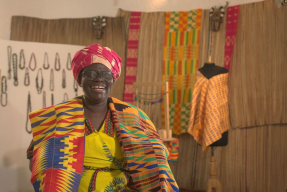A Former Kiva Fellow Launches His Own MFI in Zimbabwe
February 25, 2013Meet Henry Bartram,
A career private equity professional in London who, about a decade ago, gave up his suit and tie to manage the British Red Cross response in Aceh, Indonesia after the December 2004 tsunami.
This experience led him to more social impact opportunities and ultimately to him becoming a Kiva Fellow. Henry was a member a KF15 and KF16, serving in Liberia and Zimbabwe respectively.
Combining his business acumen and his Kiva experience, Henry sought to start his very own microfinance institution. After several months dealing with all the paper work a new venture can expect to face, and after investing a good chunk of his life savings as well, Thrive Microfinance began training in March 2012 on the outskirts of Harare, Zimbabwe and started disbursing loans from September that year.
Thrive Microfinance’s goals is very simple: “To be the number one provider of developmental microfinance in Zimbabwe.” It aims to reach financial sustainability within 2 years of starting operations with all profits retained within the business for the benefit of borrowers.
Thrive focuses on issuing loans to groups of women who can learn from and support each other. But its true value proposition is not in simply handing out loans, Thrive invests enormously into each group by teaching the woman:
- the fundamentals of running a business,
- how to save for a rainy day and
- how to benefit from working in groups.
Thrive does not ask for collateral but focusses on creating strong relationships with its borrowers through a very high level of direct contact.
“Only 25% of the groups that apply for a loan actually make it through the 2-month training as there is a considerable drop-off when they come to open their group bank account. This is intentional as we want them to get a glimpse of the reality of the group guarantee.” says Henry. “We work tirelessly from the onset to make sure that nobody takes a loan until they possess the skills necessary to determine whether is in their own best interest to do so. We only lend when we are sure that the probability of benefit is much greater than the possibility of increased vulnerability.”
The training process takes about 8 weeks and includes the following steps:
1) Group assessment interview
Prior to starting the training, groups view an information video and attend a short interview in which Thrive assesses whether there is a real business, however small it may be, and whether the members of the group really know each other. Group members are also given two fact sheets explaining Thrive as well as its approach and the cost of borrowing.
2) Introduction to working in groups
Trainees are asked to their share expectations of their leaders and discuss the advantages of working in groups. They are shown how to take a regular health check on the strength of the group.
3) Group constitution and election of leaders
The group determines its rules & regulations – where they will meet, subscriptions, penalties etc and then go on to elect their own management committee. The group then goes on to open a group bank account.
4) Leadership training
The group leaders attend a session showing the Treasurer a suggested way of keeping the group’s financial records, a suggested agenda for group meetings and a series of tips from other chairs on how to get the group working well.
5) Financial training 1
Groups are shown how to keep simple daily records summarizing their business income and expenditure.
6) Financial training 2
Groups are taught the importance or regular savings, no matter how small and work through an illustration enabling them to identify examples of both good and bad borrowing. The costs of borrowing are carefully explained.
7) Financial training 3
This session focusses on developing a shared understanding of the key features, strengths and weaknesses of each business. Members of the group form mini-groups of 2 or 3 and share their work with the rest of the group. At this point, Thrive will visit each of the potential borrowers at their place of business.
8) Financial training 4
Group members bring their ‘shopping list’, a summary of what they want to spend the money on and how they expect to benefit. Members then calculate the cost of borrowing and the monthly repayment amount and determine whether it is their own best interest to go forward. They discuss how the group guarantee concept works.
Upon completion of the training program, Thrive considers the loan applications on the basis of probable benefit to the borrower. Thrive reviews both current debt bearing capacity and anticipated benefit from the loan. Post-disbursement, Thrive meets each group every month to review progress and deal with issues as they arise. To date, Thrive has experienced very high repayment rates.
Since September 2012, when the first loan was disbursed, Thrive has issued loans totalling over $125,000 USD to over 60 groups comprised of 350 borrowers. With 6 groups having graduated to their second loan cycle, Henry is confident that Thrive will have trained and lent to over 1,000 borrowers by the end of 2013. Thrive recently completed a Client Protection Principles Questionnaire and will implement the resultant recommendations by March 2013 and will have undergone a full Social Performance audit by the year end.
You can see the Thrive video at http://youtu.be/In7NuvK-fP0
PREVIOUS ARTICLE
Following a Kiva loan from Calgary to Dar es Salaam! →NEXT ARTICLE
Capital One now matching all loans to U.S. borrowers! →

















